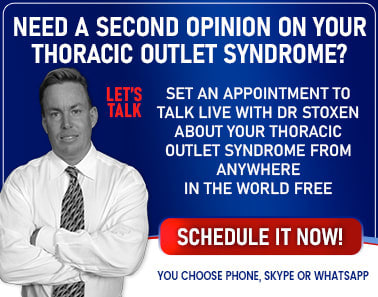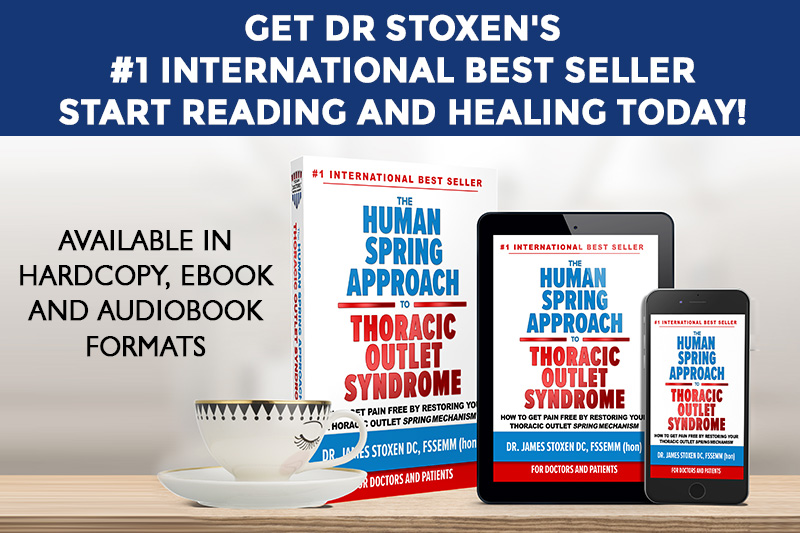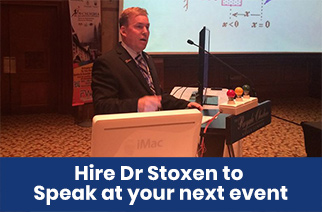These are the chapter summaries of the #1 International Bestselling Book, The Human Spring Approach to Thoracic Outlet Syndrome by Dr James Stoxen DC., FSSEMM (hon).
If you want the complete guide please go to these links to get your copy of the book.
https://www.amazon.com/dp/B07JNJTNDW
https://www.amazon.ca/dp/B07JNJTNDW
https://www.amazon.com.au/dp/B07JNJTNDW
https://www.amazon.com.br/dp/B07JNJTNDW
https://www.amazon.fr/dp/B07JNJTNDW
https://www.amazon.de/dp/B07JNJTNDW
https://www.amazon.in/dp/B07JNJTNDW
https://www.amazon.co.jp/dp/B07JNJTNDW
https://www.amazon.com.mx/dp/B07JNJTNDW
https://www.amazon.nl/dp/B07JNJTNDW
https://www.amazon.es/dp/B07JNJTNDW
https://www.amazon.co.uk/dp/B07JNJTNDW
The Chapter summaries of the #1 International Bestselling Book, The Human Spring Approach to Thoracic Outlet Syndrome by Dr James Stoxen DC., FSSEMM (hon)
Chapter 1, “What Is Thoracic Outlet Syndrome?”
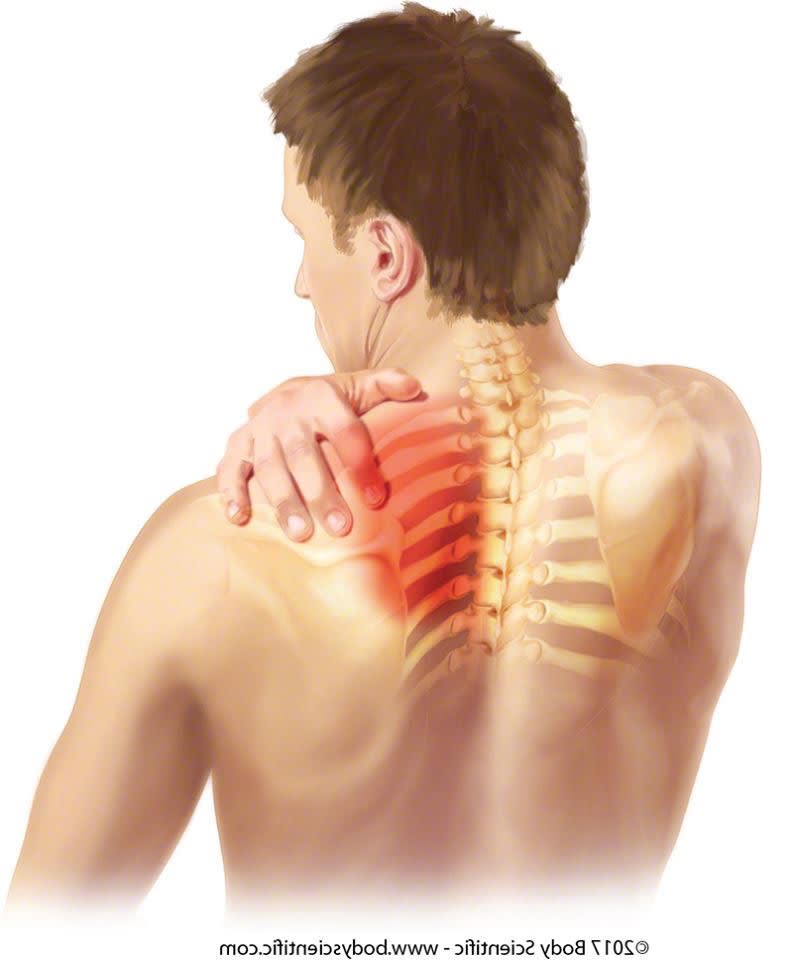
Chapter 1, “What Is Thoracic Outlet Syndrome or tos syndrome?” reveals that TOS is caused by compression of the outlet or tunnel where the blood vessels and nerves pass from the neck or the thorax to the arm. What is causing the compression?
Chapter 1, “What Is Thoracic Outlet Syndrome AKA thoracic inlet and outlet syndrome?” reveals that TOS is caused by compression of the outlet or tunnel where the blood vessels and nerves pass from the neck or the thorax to the arm leading to thoracic outlet syndrome signs and symptoms.
What is causing the compression?
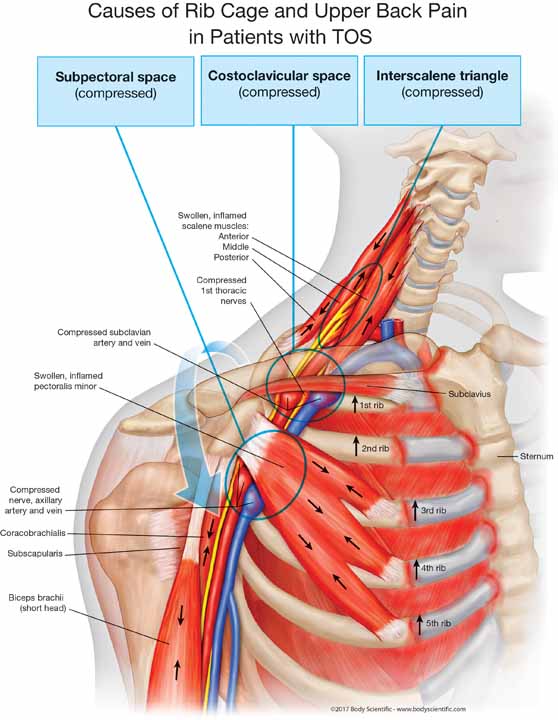
If you and your doctor know the thoracic outlet syndrome cause of the compression and know how to reverse it, you can end your suffering. Understanding this concept prevents neurogenic thoracic outlet syndrome surgery, scalenectomy and in just about every patient with TOS.
Thoracic outlet syndrome has been called many names, as mentioned previously, including office syndrome, cell phone shoulder, and cell, mobile or smartphone syndrome. Doctors have an even more confusing list of names for thoracic outlet syndrome, such as thoracic outlet disorder, arterial TOS, thoracic plexus disorder, elevated first rib syndrome, first rib thoracic outlet syndrome, first rib syndrome, 1st rib syndrome, neurogenic TOS, TOS thoracic outlet syndrome, arterial thoracic outlet syndrome, thorax syndrome, anterior scalene syndrome, scalene entrapment syndrome, upper thoracic syndrome, bilateral thoracic outlet syndrome, cervical rib thoracic outlet syndrome, acute thoracic outlet syndrome, thoracic artery syndrome, thoracic outlet syndrome brachial plexus, thoracic outlet compression syndrome, cervicobrachial neuralgia, compressive neuropathy, costoclavicular syndrome, disputed neurogenic thoracic outlet syndrome, double crush syndrome thoracic outlet syndrome, thorax outlet syndrome, effort thrombosis, hyperabduction syndrome, inflammation of the brachial plexus, neurogenic pectoralis minor syndrome (NPMS), neurogenic thoracic outlet syndrome (NTOS), neurological thoracic exit syndrome, thoracic compartment syndrome, brachial plexus compression syndrome, obstructive outlet syndrome, Paget-Schroetter syndrome, upper thoracic outlet syndrome, clavicle thoracic outlet syndrome, peripheral nerve compression, scalenus anticus syndrome, spontaneous subclavian vein (“effort”) thrombosis, subcoracoid brachial plexus compression, neuropathic thoracic outlet syndrome, postural thoracic outlet syndrome, thoracic outlet impingement, superior thoracic outlet syndrome, thoracic duct outlet syndrome, symptomatic thoracic outlet syndrome, serratus anterior thoracic outlet syndrome, thoracic outlet compression, triple crush, thoracic nerve syndrome, venous compression syndrome, venous thoracic outlet syndrome, drastic outlet syndrome and other types of thoracic outlet syndrome.

To understand this, you need to have extensive knowledge of three things:
- The thoracic outlet anatomy
- Which muscles keep the thoracic outlet and tunnel open and which close it down
- How tension is controlled in those muscles
In this chapter, I discuss exactly what thoracic outlet syndrome is and provide an extensive review of the thoracic outlet syndrome anatomy.
Included in this chapter are custom illustrations of a normal thoracic outlet and the abnormally compressed thoracic outlet. After looking at these illustrations, I guarantee you are going to better understand the thoracic outlet syndrome compression sites of simple neurogenic thoracic outlet syndrome, venous thoracic outlet syndrome, arterial thoracic outlet syndrome and the other conditions associated with this area of the body.
Most importantly you will learn the muscles involved in thoracic outlet syndrome, the TOS muscles, and how you can treat them yourself.
Chapter 2, “A Painful Misunderstanding of Human Engineering,”
Chapter 2, “A Painful Misunderstanding of Human Engineering,” I present the 340-year-old model of human engineering that doctors and other healers base their approach to examining and treating you Then I present a model of human movement proposed by Harvard University scientists that better explains how the body absorbs impacts and recycles energy. Then I present an advancement of the model proposed by Harvard University scientists I nicknamed the human spring model.
The Human Spring Model not only explains how the body absorbs impacts, recycles energy and opens spaces for joints it also eloquently explains how the human spring engineering provides a safe passage for blood vessels and nerves through the thoracic outlet or thoracic tunnel.
I present logical, easy-to-understand arguments why my model of biomechanics is the only model that explains how human bodies perform these important functions.
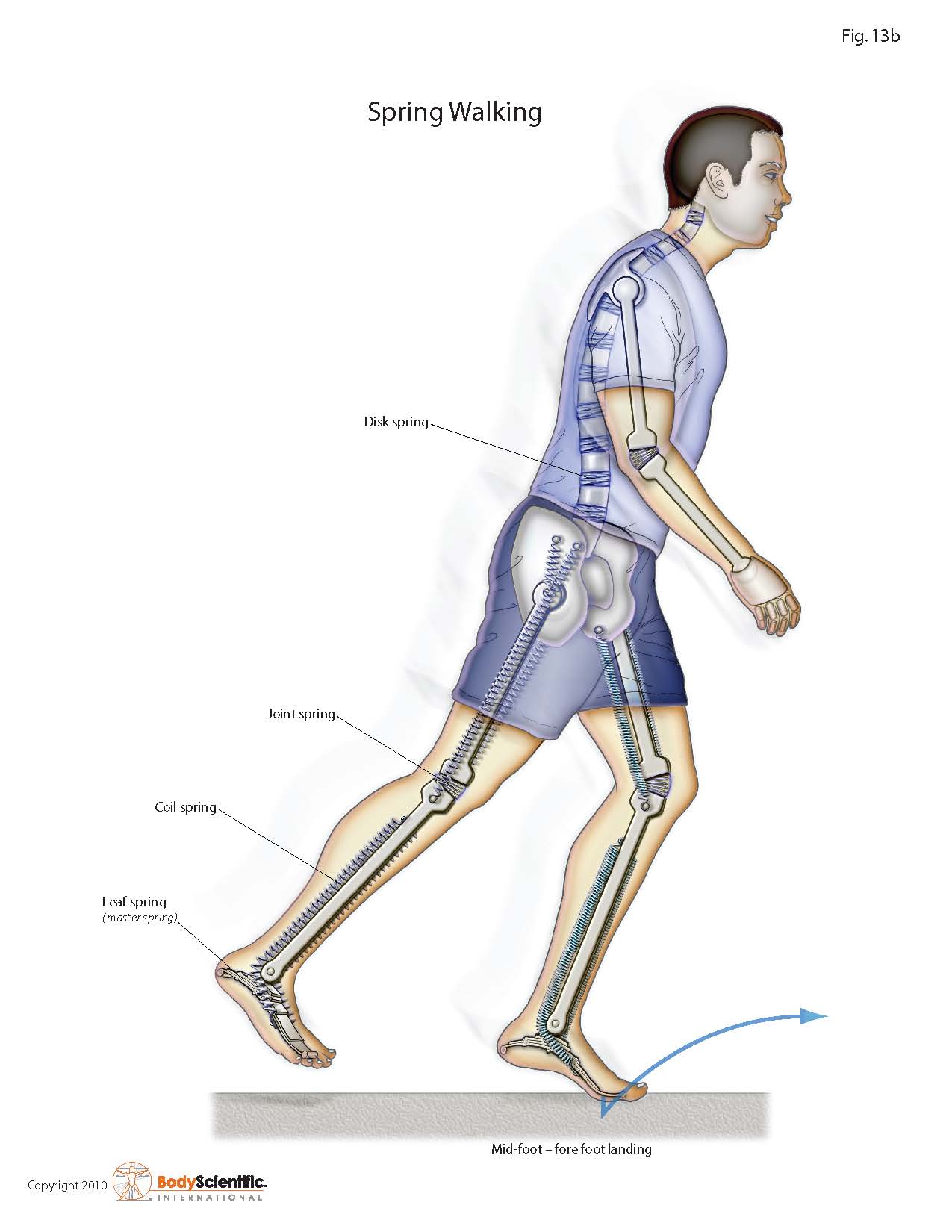
1. How does the body absorb collisions with Earth during walking and running?
A spring off the ground better protects the joints from painful arthritic conditions than a bang and a twist with a rigid lever.
2. How does the body recycle energy to prevent chronic fatigue?
A spring off the ground with elastic elements can recycle more energy than a bang and a twist with a rigid lever.
3. How does the body open spaces for joints, such as the ankles, the knees, and the hips?
A spring can open spaces for knees where the body cannot open spaces with a lever mechanism.
4. How does the body open spaces and tunnels for the safe passage of blood vessels and nerves?
Springs and spring-suspension engineering can suspend the shoulder over the thoracic outlet and tunnel. It’s impossible to open a tunnel between the shoulder and the chest to let blood vessels and nerves pass safely into the arm with human levers.
You will learn that this lever-series model cannot explain these important functions the body must do and, in fact, it does not even abide by the laws of nature and physics. I will present scientific fact that proves the human body uses spring engineering to complete these four tasks.
When I’m done, you will agree that my human spring model is more logical and it must replace the old, outdated, and wrong lever-series model. Don’t worry, doctors around the world agree with me, so there should not be any arguments about this.
Chapter 3, “Human Spring Engineering,”

Chapter 3, “Human Spring Engineering,” explains thoroughly, in simple terms, how looking at the human body as a spring is a more comprehensive and logical model for understanding how the body works according to the laws of physics and nature.
Looking at the human body modeled as a spring allows you to fill the gap of what is misunderstood about the human body. It gives you an approach that is well-researched, sound in principle, and, best of all, delivers optimum results.
Chapter 4, “The Control of Tension on Your Human Spring,”
Chapter 4, “The Control of Tension on Your Human Spring,” I discuss how we can make changes in the tension of our body’s spring as a part of everyday life. When you step off a curb, you know exactly the amount of tension to have a safe landing. Gymnasts know exactly how much tension to have on their bodies for a safe landing. Jogging is different from sprinting, only by the level of tension in the lower body spring.
This change in tension is considered normal and essential to live in harmony with Earth’s gravity. How does this apply to your thoracic outlet syndrome?
Chapter 5, “The Cause of Compression!”
Chapter 5, “The Cause of Compression!” discusses the difficulties that doctors have in diagnosing the thoracic outlet syndrome cause.
The Mayo Clinic, the Cleveland Clinic, and the National Institute of Neurological Disorders and Stroke, plus top-10 ranked hospitals for neurology and neurosurgery tell us that compression is what leads to thoracic outlet syndrome.
However, this spring tension can get out of your control. This happens when reflexes in the brain take over and dominate the tension, putting you in an abnormally compressed state of pain and suffering.
Therefore, how this tension is controlled by reflexes is extremely important for the understanding of the cause of thoracic outlet syndrome, herniated discs, headaches, and many other painful conditions caused by compression.
This was the “aha” moment that determined what was getting in the way of the healing process. Understanding that tension creates drag on the energy-saving spring system is what explains the cause of chronic fatigue syndrome.
So, if doctors and other healers don’t know how these important parts of the body are engineered and how the tension is controlled that causes the compression then how could they possibly reduce the thoracic outlet obstruction on the outlet and tunnel back to normal?
Chapter 6, “Break These Laws . . . Get Sentenced to a Lifetime of Suffering”

Chapter 6, “Break These Laws . . . Get Sentenced to a Lifetime of Suffering” lists the most common activities of daily life that violate the laws of physics and nature to put you in disharmony with Earth’s gravity, leading to the cause of compression. When your movements and posture are not in harmony with gravity, your nervous system will react and twist you into a chronic state of suffering.
In this chapter, I present simple rules you must follow in your everyday life to abide by the laws of nature and physics, so your nervous system can remain in harmony with the pull of Earth’s gravity.

Here I educate you on the best sleeping posture, sitting posture, multitasking, and computer use, such as use of the mouse, keyboard, monitor position, and visual stressors. I review the dangers of overuse of your mobile phone, smartphone, remote controls, and other handheld devices. I also review occupational injuries and an instantaneous overloading strain caused by auto accidents and personal injuries.
If you follow these rules and remove these activities that cause a reaction of your nervous system to compress your human spring, a lot of your suffering will be reduced, even without thoracic outlet syndrome management like thoracic outlet syndrome physical therapy or thoracic outlet syndrome chiropractic care for chiropractic treatment for thoracic outlet syndrome.
Chapter 7, “How Do They Diagnose It?”
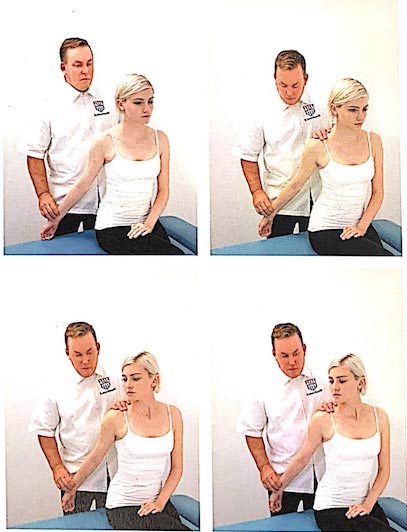
Chapter 7, “How Do They Diagnose It?” discusses why it is that so many conservative, nonsurgical thoracic outlet syndrome treatments fail thoracic outlet syndrome sufferers and all other conditions and disorders caused by compression of your body.
Most important, your road to recovery starts with the doctor’s examination.
Your doctor illogically uses examinations with lever movements to determine why your body’ spring system is compressed. It’s illogical!
In this chapter, I review the only way to determine if your thoracic outlet is compressed and what is compressing it. This requires doctors to touch you all over. Most don’t even touch you where it hurts! Don’t you hate that? When they don’t touch you where it hurts, you begin to become skeptical of their medical opinions, don’t you? I did! Maybe that is why you need to read this book.
I will teach you how you should be examined. I will review the key orthopedic tests and examinations that will uncover the thoracic outlet syndrome causes of your pain and suffering.
Most important, I will teach you the way to examine yourself. Then you can fire your doctor and treat yourself with the self-treatment I provide in Chapter 13, “What Works and Why.”
Chapter 8, “More Tests?”

Chapter 8, “More Tests?” reviews why most patients think that diagnostic tests might be able to spot thoracic outlet syndrome or a herniated disc.
You’ll understand after reading this book that if doctors tell you they can diagnose thoracic outlet syndrome or most musculoskeletal conditions with a single test, such as an MRI, they are not being truthful.
In fact, the findings on your MRI, that you eagerly await, oftentimes lead your doctor to a wrong diagnosis. This will delay your recovery. What is worse is that it could lead you into unnecessary thoracic outlet syndrome surgery. Getting cut open to have metal plates screwed into your neck, when you never needed it, will leave you in pain from the TOSe surgery, and you will still have same TOS symptoms and signs of thoracic outlet syndrome.
In 2016, I gave a presentation “The Earliest Detection, Intervention and Prevention of Compression Syndromes, TOS, Herniated Discs and Degenerative Joint Disease” at the World Congress of Anti-Aging and Longevity, Mexico City, Mexico.
Did I talk about the latest diagnostic tests? Yes! Here is the scientific study that confused the doctors in the audience.
I presented three individual studies, conducted by Japanese researchers who performed MRI scans on volunteers who were completely pain free. The volunteers had never had pain in their necks or backs in their life.
The researchers found that more than 30 percent of the volunteers had herniated disks that they did not know they had.
Doctors know that with an MRI scan, they have a greater than 30 percent chance of finding a herniated disc. If you had this herniated disc before you had the onset of thoracic outlet syndrome pain or pinched nerve symptoms, this is not the cause of your pain. But they will probably tell you it is. Are they trying to trick you or do they just not know?
For more than 30 percent of you, the MRI will reveal a herniated disc you had before the onset of pain. That finding of a herniated disc will confuse even a well-meaning doctor. The difference is that now you are face to face with a neurosurgeon.
Again, this huge misunderstanding of the results of MRI scans and other diagnostic tests, can lead to a misdiagnosis, mistreatment, and a lifetime of suffering you don’t need. Because you don’t know fully understand these tests, a doctor can tell you anything and you believe him.
That ends right here and right now.
Chapter 9, “Is It TOS, This, That, or All the Above?”

Chapter 9, “Is It TOS, This, That, or All the Above?” teaches you that patients with thoracic outlet syndrome are the most misdiagnosed, mismanaged, misinformed, and mistreated patients today.
Treatments fail when the treatment is applied to the wrong diagnosis. It is possible that failed attempts at conservative management are related to the wrong diagnosis or in incomplete diagnosis. Keeping it simple, the patient is simply misdiagnosed.
What is even more challenging for you is that the majority of physicians who get the thoracic outlet syndrome diagnosis or pec minor syndrome diagnosis right get the thoracic outlet syndrome cause wrong. Because they don’t treat the cause, even with the right tos diagnosis, the TOS treatment approach is destined to fail.
Many time-strapped doctors today, in all branches of medicine, typically spend 10 to 15 minutes or less with each patient—not because they don’t care, but because there are simply not enough hours in the day to meet the demands for an in-depth examination.
How are doctors supposed to be able to differentiate if you have thoracic outlet syndrome or 30 other conditions that mimic thoracic outlet syndrome? If it’s their area of expertise, it takes an hour to really do a thorough examination.
Here is a list of the 30 different conditions that mimic thoracic outlet syndrome.
- Herniated disc, bulged disc, slipped disc, sixth nerve root
- Herniated disc, bulged disc, slipped disc, seventh nerve root
- Herniated disc, bulged disc, slipped disc, T1 nerve root
- Cervical radiculopathy, brachial plexus injury, or brachial neuritis
- Cervical spondylosis
- Neck trauma
- Thoracic disc injuries
- Clavicle injuries—acromioclavicular joint injury
- Clavicle fracture malunion
- Inflammatory conditions of the shoulder (tendonitis arthritis)
- Shoulder impingement syndrome or hyperabduction syndrome
- Rotator cuff inflammation
- Intercostal neuritis (pinched nerve between the ribs)
- Cubital tunnel compression
- Carpal tunnel syndrome
- Guyon’s canal
- Median nerve entrapment
- Double crush
- Triple crush
- Quadruple crush
- Vascular diseases (atherosclerosis)
- Paget-Schroetter syndrome or effort thrombosis
- Pancoast’s tumor
- Spinal cord tumor or neoplasm
- Complex regional pain syndrome (reflex sympathetic dystrophy)
- Degenerative spinal cord disease—MS
- Degenerative spinal cord disease—syringomyelia
- Raynaud’s phenomenon
- Cervical ribs and fibrous bands
- Myofascial Thoracic Outlet Syndrome
All these conditions mimic the thoracic outlet symptoms. So, if you only got that 10–15-minute history and examination, and then the doctor made a diagnosis, or if the treatment approach the doctor is using isn’t getting you the results you expected, you might be misdiagnosed.
Also, what really confuses doctors and patients is that you could be underdiagnosed. What that means is that you were diagnosed with carpal tunnel syndrome, but in reality you have carpal tunnel syndrome, median nerve entrapment, rotator cuff tear, and a thoracic outlet syndrome at the same time.
If it’s not the doctors’ area of expertise, and they don’t know what goes into a thorough exam, you’ll probably get 10 minutes of chitchat. If you don’t know some basic thoracic outlet anatomy (for example, how the thoracic outlet is engineered, how you should be examined), then a doctor could simply skim over the exam, never touching the area that hurts, and instead order an MRI scan and a referral to a neurosurgeon.
Do you wish there was a way to fact check your doctor’s thoracic outlet syndrome diagnosis?
Well, in this chapter, we will review each of the 30 different diagnoses that could be considered with your array of symptoms and give you tips on how you can differentiate between each of them and thoracic outlet syndrome symptoms.
Chapter 10, “What Thoracic Outlet Syndrome Treatment Doesn’t Work And Why?”

Chapter 10, “What Thoracic Outlet Syndrome Treatment Doesn’t Work And Why?” reviews my exhaustive research of more than 2,500 studies in the U.S. National Library of Medicine, part of the National Institutes of Health database. This is the complete list of thoracic outlet syndrome treatment procedures and approaches studied for the treatment of thoracic outlet syndrome. I can almost guarantee the thoracic outlet syndrome treatment approach used by your doctor is on this list.
- Medication: analgesic drug therapy, antidepressants, anticonvulsants, others
- Scalene injection for scalene syndrome (bupivacaine)
- Nonsteroidal anti-inflammatory drugs (NSAIDS)
- Painkillers for symptom reduction
- Scalene injection (Botox)
- Gentle stretching of the scalenes and pectoralis minor
- Traction
- Ner ve gliding
- Ultrasound and muscle stimulation
- Different bra for breast hypertrophy
- Breast reduction—reduction mammoplasty
- Ergonomic corrections
- Correction of the ergonomics of the workstation
- First rib adjustments, alone
- General massage
- Exercise strengthening
Which one do you think, by itself, removes the compression on the outlet?
None of them!
Now do you wonder why you’re not getting better?
I will provide simple and logical explanations of why these 16 thoracic outlet syndrome treatment approaches, individually, cannot reverse the thoracic outlet syndrome cause.
If thoracic outlet syndrome treatment and training approaches are not compatible with true engineering of the body and are contrary to the laws of physics, that means they are destined to fail. And you know what? Time and time again, they do fail.
Much of the current, standard-of-care for thoracic outlet syndrome treatments, including adjustments, mobilizations, stretching, rehab exercises, injections, medications, and surgeries are destined to fail to achieve true maximum medical improvement, because the removal of the tension on your human spring is not addressed.
Vertebral discs and the thoracic outlet and tunnel are engineered with spring mechanics. Doctors cannot reverse the compression on your body’s spring mechanism with treatment approaches that are only effective on lever mechanisms.
What is logical about a doctor not knowing the engineering of a machine he is paid to fix?
Chapter 11, “When in Doubt, Cut It Out?”

Chapter 11, “When in Doubt, Cut It Out?” will provide additional information about why doctors want to perform thoracic outlet syndrome surgery for thoracic outlet syndrome pain relief of an easy to reverse neurogenic thoracic outlet syndrome (neurogenic TOS). After enough neurogenic thoracic outlet syndrome treatments, that are designed to treat lever mechanisms, fail to decompress your spring mechanism, you elect to try thoracic outlet surgery. You tried everything, so, when in doubt, cut it all out, right?
Don’t forget, doctors are magicians. They can cut the thoracic outlet pain right out of your body. You can’t think this way!
Because the doctors could not find a conservative approach to relaxing tight scalenes, they cut them out. Because the tight scalenes are causing a raised first rib, compressing the blood vessels and nerves between the first and second rib, they cut your rib out too. This is what happens when you try to manage your thoracic outlet syndrome by simply searching google for thoracic outlet syndrome doctors near me.
So, do you really still think doctors do thoracic outlet syndrome surgery because they tried every logical, conservative approach? You would think there is a more logical way to stop the spasms of the muscles and to adjust the ribs down out of the outlet and tunnel rather for thoracic outlet syndrome or costoclavicular syndrome than cutting them out, right?
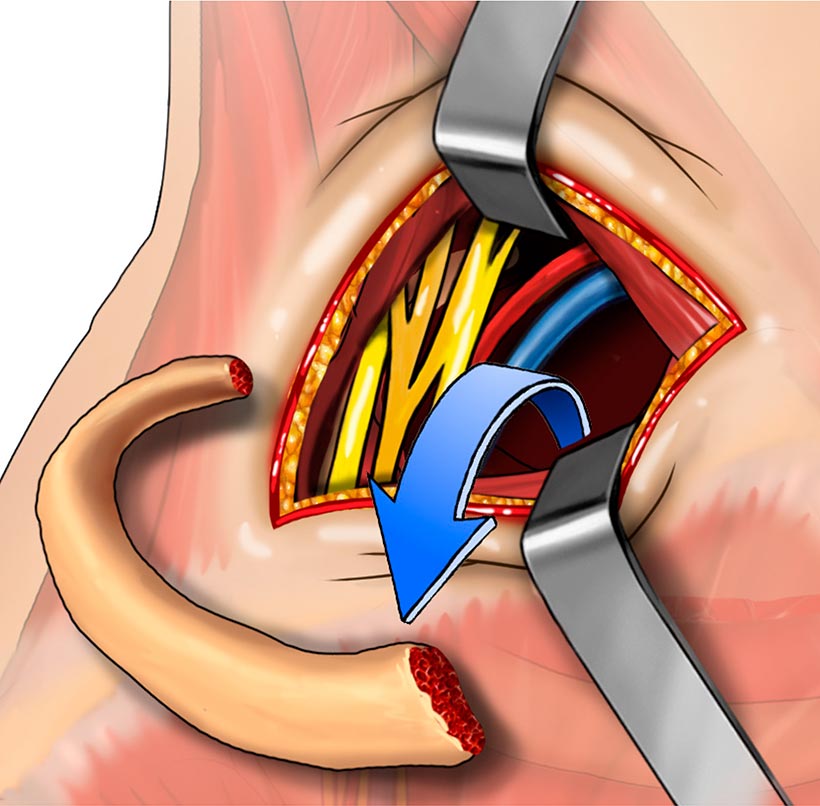
Should thoracic outlet syndrome surgery be a last resort? After reading this book, you will agree that thoracic outlet syndrome surgery or pectoralis minor syndrome surgery for a compressive disorder, like TOS, and herniated discs, are more like a painful misunderstanding of human engineering, than a last resort.
Chapter 12, “Paget-Schroetter Syndrome?”
Chapter 12, “Paget-Schroetter Syndrome?” asks, “Is thoracic outlet syndrome dangerous?”

If you make mistakes in your game plan to reverse this complex disorder or wait too long, untreated thoracic outlet syndrome could put you at risk for some real danger.
With subclavian vein compression symptoms named vascular thoracic outlet syndrome or venous TOS you don’t have a lot of pain. You have venous thoracic outlet syndrome symptoms like swelling in the hand.
In fact, a thoracic outlet syndrome blood clot could form in the area of the narrowed vein before you get subclavian vein compression symptoms. If this clot dislodges, it can flow into your lung, causing lung tissue to die, and you end up with difficulty breathing or even death. This is called Paget-Schroetter syndrome.
This is not arterial TOS from subclavian artery compression. You don’t commonly get blood clots in the artery.
I review Paget-Schroetter syndrome in-depth, and I commissioned a beautiful illustration that explains Paget-Schroetter syndrome for you perfectly so you “get it.”
I give you the latest in venous thoracic outlet syndrome treatment later in the next chapter.
Chapter 13, “What Works and Why?”

Chapter 13, “What Works and Why?” Everyone is looking for a conservative treatment for thoracic outlet syndrome for their thoracic outlet syndrome cure and are willing to try anything and everything. However there are only two thoracic outlet syndrome treatments than can effectively reduce the compression that causes thoracic outlet syndrome.
Here I outline the effective thoracic outlet syndrome treatment of the muscle tension for reducing the compression. That is the thoracic outlet syndrome etiology. You will see conservative treatment of thoracic outlet syndrome because this is the only way to drop the first ribs out of the outlet, with adjustments. Either you get adjustments to drop the rib or they cut the rib out. Which do you prefer?
I had a photographer take pictures of a model demonstrating these thoracic outlet syndrome self treatments, like self-massage and stretching methods that will begin to ease your thoracic outlet syndrome symptoms along with pectoralis minor syndrome symptoms and get you on the road to thoracic outlet syndrome relief.
I also list the most powerful therapy that doctors should be using to quickly reduce inflammation, pain, and the tense muscles that are compressing your thoracic outlet and twisting your frame into a chronic state of suffering.

The reason most doctors aren’t using it is because they can’t get paid by the insurance companies for the thoracic outlet syndrome treatment. Most doctors don’t do therapies unless they can make a buck.
What is great is that you don’t need to be a doctor to use it, so you can buy it and use it yourself to help you get better without the doctor’s help.
Chapter 14, “Spring Training!”

Chapter 14, “Spring Training!” tells you my personal story. Several years ago, my friend and I were in a really bad car accident. The 70-mile-per hour impact into a concrete median totaled her car and caused significant injuries. The accident caused her spinal trauma, an upper back injury, a disc bulge, thoracic outlet syndrome symptoms, thoracic outlet syndrome chest pain and the symptoms of mild concussion.
After the accident, I had no pain whatsoever. What?
I had been doing the spring strengthening training listed in Chapter 14 and also barefoot running. So, the reason I did not get hurt was because my “spring training” approach to strengthening the human spring to resist these incredible forces of impact, so it not only rehabilitates, it also protects, therefore, it prevents.
I hired one of the top photographers from Muscle & Fitness and Shape magazines, Bill Dobbins, to shoot color photos of top fitness models, Rachel Moore and Sherry Goggin, demonstrating these exercises and stretches.
I also hired Chicago photographer Stan Magoni to photograph model Gabija Guzauskaite performing the 10 recommended stretches and the exercises we use to open up strengthen the thoracic outlet area of our TOS patients. These photos were taken at the River North Crossfit and at Team Doctors® Rehabilitation and Training Center in Chicago.
There are 30 stretches and exercises for thoracic outlet syndrome designed to widen and strengthen the muscles of your thoracic outlet. These exercises will also help you prevent injuries to your neck in car accidents, work injuries, and sports injuries.
The increased blood flow and strengthening of the muscles of the back, chest, neck, and shoulders greatly improve your posture and help you fight the fatigue from sitting for long sessions at the computer. Also it will improve the prognosis for thoracic outlet syndrome not returning.

Also, I will teach you which thoracic outlet syndrome stretches will make you worse.
Chapter 15, “Conclusion”
Chapter 15, “Conclusion” explains how the odds are against you recovering from thoracic outlet syndrome. The thoracic outlet syndrome prognosis can be enhanced with what you learned in this book and my help you will get through this! You obviously cannot google doctors specializing in thoracic outlet syndrome near me to find thoracic outlet syndrome doctors. Its too difficult so you need thoracic outlet syndrome specialists which are doctors specializing in thoracic outlet syndrome that do nothing but treat thoracic outlet syndrome.
This book is about the earliest detection, intervention, and prevention of thoracic outlet syndrome so you don’t get chronic thoracic outlet syndrome or surgery and thoracic outlet syndrome surgery recovery that does not improve your condition or you end up in even more pain.
However, it’s more than just about this condition. In this book, you will learn an entirely new model and approach that helps you understand the mysteries to why the body breaks down, doesn’t heal, and degenerates into a chronic state of suffering.
It also provides many secrets to restoring human performance and preserving the health of the human body. You will learn new ways of thinking about lifestyle choices, exercise, and how your doctors examine and treat you. And it all makes sense, because it follows principles of nature and engineering that are easy to understand.
I strongly feel that the current standard of care must be replaced by examination, treatment, and prevention protocols that are based on the way the universe works. After reading this book, you will realize that the only model of human movement that abides by these laws is the human spring model.
I’m positive you will agree that evaluating and treating you as a human spring is the only way doctors achieve the predictable positive outcomes like we see every day using this model and approach.
I guarantee you that after you read this book you will not allow your doctor to examine and treat you the same way ever again!
Read on to discover more “aha” moments.

Dr James Stoxen DC., FSSEMM (hon) He is the president of Team Doctors®, Treatment and Training Center Chicago, one of the most recognized treatment centers in the world.
Dr Stoxen is a #1 International Bestselling Author of the book, The Human Spring Approach to Thoracic Outlet Syndrome. He has lectured at more than 20 medical conferences on his Human Spring Approach to Thoracic Outlet Syndrome and asked to publish his research on this approach to treating thoracic outlet syndrome in over 30 peer review medical journals.
He has been asked to submit his other research on the human spring approach to treatment, training and prevention in over 150 peer review medical journals. He serves as the Editor-in-Chief, Journal of Orthopedic Science and Research, Executive Editor or the Journal of Trauma and Acute Care, Chief Editor, Advances in Orthopedics and Sports Medicine Journal and editorial board for over 35 peer review medical journals.
He is a much sought-after speaker. He has given over 1000 live presentations and lectured at over 70 medical conferences to over 50,000 doctors in more than 20 countries. He has been invited to speak at over 300 medical conferences which includes invitations as the keynote speaker at over 50 medical conferences.
After his groundbreaking lecture on the Integrated Spring-Mass Model at the World Congress of Sports and Exercise Medicine he was presented with an Honorary Fellowship Award by a member of the royal family, the Sultan of Pahang, for his distinguished research and contributions to the advancement of Sports and Exercise Medicine on an International level. He was inducted into the National Fitness Hall of Fame in 2008 and the Personal Trainers Hall of Fame in 2012.
Dr Stoxen has a big reputation in the entertainment industry working as a doctor for over 150 tours of elite entertainers, caring for over 1000 top celebrity entertainers and their handlers. Anthony Field or the popular children’s entertainment group, The Wiggles, wrote a book, How I Got My Wiggle Back detailing his struggles with chronic pain and clinical depression he struggled with for years. Dr Stoxen is proud to be able to assist him.
Full Bio) Dr Stoxen can be reached directly at teamdoctors@aol.com









